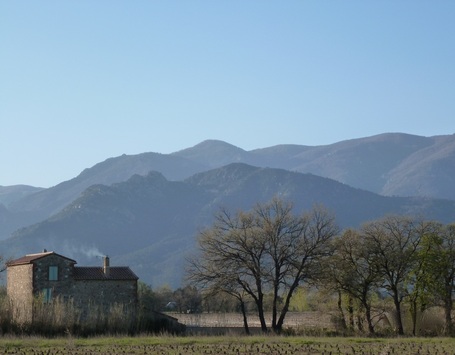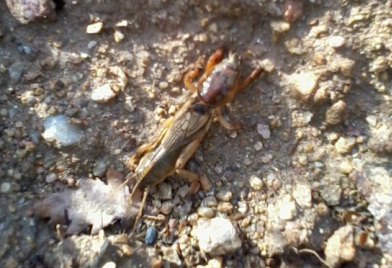As I have mentioned, quite a lot of the birds that I see in my garden are familiar from the Scottish Highlands, but if there is ever any danger of forgetting that I live now in a place that is really rather exotic and special, then it is always worth going to the coast and looking at the "local" Étang. I am not completely sure how the flat plain of the Roussillon evolved, but between us and Italy there is really quite a lot of sea, and thousands of years of east winds have created long ridges of sand and shingle, enclosing a whole number of lagoons. This sort of landscape stretches a long way, from the Camargue down to where the Albères run into the Mediterranean in the rocky coast of the famed Côte Vermeille. Our local étang is the last of these lagoons, and is called the Étang de Canet (ou de St. Nazaire, according to the map) , and is no distance from where most of us live. The seaward side is easily accessible just beyond (going north) where the shore road crosses its exit to the sea, the channel called "the Grau". Here there are some fishermen's huts and you get good views over the large expanse of open water. It may often not look very special or exotic, as the wind churns up the sediments and the water can look pretty murky; the wind has the added disadvantage, often, of driving many of the birds to the other, rather less accessible, side.
However, in the winter, this area of water, like many of the others further north, is home to a group of flamingos, and few birds can be more exotic or look special than a flamingo! Their profile, to start with, is quite unlike that of anything else, and when I arrived there on a visit in December, two flew along the shore behind the cabins, just as I was getting out of the car. There was, therefore, something of a rush to get a view of where they had landed and I was in luck: although one had disappeared, the other had stayed close in, and I stalked it till I got a reasonable view-at which point, it was just beside an egret; a nice combination! The flamingo was, I think, quite young and looked rather gawky and colourless. When they get older, they become really spectacular, with deep pink, and black on the wings. On my most recent trip, although they were more distant, the deeper colour showed up well in the sunlight: there were many of them visible along the far shore. I have just noticed that one of my bird books says that they breed here, which is news to me- any comments on this are welcome!
Halfway across the water, but closer to the channel out to sea, was a large group of birds which I eventually estimated at about two hundred. These, though much smaller of course, were in their own way almost as spectacular as the flamingos: they were great-crested grebes. To me they are almost as exotic as flamingos as they almost never came north into the Highlands, and remained very much birds of the fertile lowlands. The adjective " great crested " is something of an approximation, as what you actually see are conspicuous ear-tufts and a frill around the neck- called, rather sweetly, I think, a " tippet " according to the same book! It was, interestingly, these " additions" which helped me identify them- I say interestingly, because they are part of the birds' summer plumage, and this was the middle of February. In the hide alongside me was a Catalan birdwatcher and photographer who described to me their very complex courtship rituals: it is as well I had some clue what he was talking about, as my Catalan is non-existent! The same bird book has come my rescue again (thank heavens for them!), as it says that the first eggs may be laid as early as the end of February.
Around the huts were a few larks hopping around on the ground and not very shy: they had very distinct crests, and were clearly not the British skylark. The book shows colour variations which were not clear to me and mentions rather ominously that there are four European races of the Crested Lark, but adds that they are all very similar to each other!
Moving swiftly on, (and it tended to!), there was also a hoopoe around the huts which gave me a lot of pleasure. There can be little more exotic than this amazing bird; there is no need to describe it, as almost everyone knows what they look like! The books (sorry!) suggest that this one was rather early back here, adding to my confusion as to whether this will be a late or an early spring!
When I was listing the garden birds, I forgot one which has obsessed me for years and certainly counts as exotic- the bee-eater. When they are migrating, it is very hard to get a decent view of them, but I love their call and am forever rushing into the garden to see if I can get that slightly better view this time. Mysteriously, it seems to me that the autumn migration of such birds often counts as a more definite " event" than does the spring, even allowing for the fact that more birds must fly south after the breeding season, than flew north in the spring. They will very soon be on the move, so get out there and look for them!

